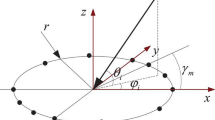Abstract
In the antenna array signal processing, a lot of interest has been given towards large number of samples which is asymptotic case. In certain cases like automotive radar applications only few or in the worst condition one sample (snapshot) of radar sensor is available for the direction finding. Hence single snapshot based direction of arrival (DOA) algorithms are required for such cases. Two such methods, namely, single snapshot root-multiple signal classification (MUSIC) and single snapshot estimation of signal parameters via rotational invariance technique (ESPRIT) algorithms using uniform linear array (ULA) are proposed. The experimental results clearly show that the proposed methods with single snapshot and the classical methods with 100 snapshots have almost similar performance. This results in ten times increase in execution. Hence the proposed methods are computationally efficient and can be used in advanced radar communications where latency is an important issue.











Similar content being viewed by others
References
Schmidt, R. O. (1986). Multiple emitter location and signal parameter estimation. IEEE Transactions on Antennas and Propagation, 34(3), 276–280.
Roy, R. H., & Kailath, T. (1989). ESPRIT-estimation of parameters via rotational invariance techniques. IEEE Transactions on Acoustics, Speech, and Signal Processing, 37(7), 984–995.
Barabell, A. J. (1983) Improving the resolution performance of eigen structure-based direction finding algorithms. In IEEE proceedings of international conference on acoustics, speech, and signal processing (Vol. 8, pp. 336–339).
Hacker, P., & Yang, B. (2010). Single snapshot DOA estimation. Advances in Radio Science, 8, 251–256.
Dakulagi, V., & Bakhar, M. (2018). Efficient Blind Beamforming Algorithms for Phased Array and MIMO RADAR. IETE Journal of Research, 64(2), 241–246.
Veerendra, Bakhar, Md., & Vani, R. M. (2014). Implementation and optimization of modified MUSIC algorithm for high resolution DOA estimation. In IEEE proceedings of international conference on microwave and RF conference (pp. 193–197).
Gershman, A. B. (1997). Improved DOA estimation of spatial spectrum. IEEE Signal Processing Letters, 4(2), 54–57.
Qian, C. (2014). Improved unitary root-MUSIC for DOA estimation based on pseudo-noise resampling. IEEE Signal Processing Letters, 21(2), 140–144.
Qian, Cheng. (2014). Improved unitary root-MUSIC for DOA estimation. IEEE Signal Processing Letters, 21(2), 140–144.
Qian, C., & Huang, L. (2012). A low-complexity Nyström-based algorithm for array subspace estimation. In Proceedings of IMCCC, China (pp. 112–114).
Veerendra, Bakhar, Md., & Vani, R. M. (2015). Smart antenna system for DOA estimation using Nyström based MUSIC algorithm. International Journal of Science and Research (IJSR), 4(4), 786–789.
Cao, M.-Y., Huang, L., Qian, C., Xu, J.-Y., & So, H. C. (2015). Under determined DOA estimation of quasi-stationary signals via Khatri-Rao structure for uniform circular array. Signal Processing, 106, 41–48.
Jeng, S., Lin, H., Okamoto, G., Xu, G., & Vogel, W. J. (1997). Multipath direction finding with subspace smoothing. IEEE Transaction on ASSP, 5(21–24), 3485–3488.
Max, M., & Sheinvald, J. (1994). Direction finding of coherent signals via spatial smoothing for uniform circular arrays. IEEE Transaction on Antennas and Propagation, 42(5), 613–620.
Bakhar, Md. (2017). A novel LMS beamformer for adaptive antenna array. Procedia Computer Science, 115, 94–100.
Dakulagi, V., Noubade, A., Agasgere, A., Doddi, P., & Fatima, K. (2019). Modified adaptive beamforming algorithms for 4G-LTE smart-phones. In Soft Computing and Signal Processing. Advances in Intelligent Systems and Computing, Springer (Vol. 898, pp. 561–568).
Veerendra, Bakhar, Md., & Vani, R. M. (2016). Robust blind beam formers for smart antenna system using window techniques. Procedia Computer Science, 93, 713–720.
Acknowledgements
This research work has partly been carried out with the support of the defense research development organization (DRDO), Bangalore, to which the authors would like to express their gratitude.
Author information
Authors and Affiliations
Corresponding author
Additional information
Publisher's Note
Springer Nature remains neutral with regard to jurisdictional claims in published maps and institutional affiliations.
Rights and permissions
About this article
Cite this article
Dakulagi, V., Bakhar, M. Smart Antenna System for DOA Estimation using Single Snapshot. Wireless Pers Commun 107, 81–93 (2019). https://doi.org/10.1007/s11277-019-06241-0
Published:
Issue Date:
DOI: https://doi.org/10.1007/s11277-019-06241-0




